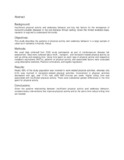| dc.contributor.author | Haregu, T. N. | |
| dc.contributor.author | Khayeka, C. | |
| dc.contributor.author | Ngomi, Nicholas N. | |
| dc.contributor.author | Oti, S. | |
| dc.contributor.author | Egondi, T. | |
| dc.contributor.author | Kyobutungi, C. | |
| dc.date.accessioned | 2021-03-24T09:06:08Z | |
| dc.date.available | 2021-03-24T09:06:08Z | |
| dc.date.issued | 2016-03 | |
| dc.identifier.citation | J Phys Act Health . 2016 Aug;13(8):830-7. doi: 10.1123/jpah.2015-0510. Epub 2016 Mar 21. | en_US |
| dc.identifier.uri | https://journals.humankinetics.com/view/journals/jpah/13/8/article-p830.xml | |
| dc.identifier.uri | https://pubmed.ncbi.nlm.nih.gov/26998581/ | |
| dc.identifier.uri | https://www.researchgate.net/publication/299342174_Analysis_of_Patterns_of_Physical_Activity_and_Sedentary_Behavior_in_an_Urban_Slum_Setting_in_Nairobi_Kenya | |
| dc.identifier.uri | https://aphrc.org/publication/analysis-of-patterns-of-physical-activity-and-sedentary-behavior-in-an-urban-slum-setting-in-nairobi-kenya/ | |
| dc.identifier.uri | https://europepmc.org/article/med/26998581 | |
| dc.identifier.uri | http://hdl.handle.net/123456789/4552 | |
| dc.identifier.uri | https://doi.org/10.1123/jpah.2015-0510 | |
| dc.description.abstract | Background: Insufficient physical activity and sedentary behavior are key risk factors for the emergence of noncommunicable diseases in the sub-Saharan African setting. Given the limited evidence base, research is required to understand the trends.
Objectives: This study describes the patterns of physical activity and sedentary behavior in a large sample of urban slum residents in Nairobi, Kenya.
Methods: We used data collected from 5190 study participants as part of cardiovascular disease risk assessment. Data were collected about work-, transport-, and recreation-related physical activity as well as sitting and sleeping time. Using time spent on each type of physical activity and respective metabolic equivalents (METs), patterns of physical activity and associated factors were evaluated using descriptive statistics, Pearson correlations, and logistic regression.
Results: Nearly 50% of the study population was involved in work-related physical activities, whereas only 6.3% was involved in recreation-related physical activities. Involvement in physical activities decreased with age, and 17.4% had <600 MET-minutes per week. Higher sitting time was associated with insufficient physical activity. There were substantial gender differences in the time spent for physical activity.
Conclusions: Given the positive relationship between insufficient physical activity and sedentary behavior, complementary interventions that improve physical activity and at the same time reduce sitting time are needed. | en_US |
| dc.language.iso | en | en_US |
| dc.title | Analysis of Patterns of Physical Activity and Sedentary Behavior in an Urban Slum Setting in Nairobi, Kenya | en_US |
| dc.type | Article | en_US |

